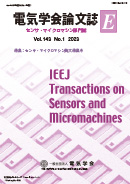
- IEEJ Transactions on Industry Applications
- IEEJ Transactions on Electronics, Information and Systems
- IEEJ Transactions on Power and Energy
- IEEJ Transactions on Fundamentals and Materials
- The Journal of The Institute of Electrical Engineers of Japan
- The transactions of the Institute of Electrical Engineers of Japan.C
- The transactions of the Institute of Electrical Engineers of Japan.B
- The transactions of the Institute of Electrical Engineers of Japan.A
- The Journal of the Institute of Electrical Engineers of Japan
- |<
- <
- 1
- >
- >|
-
Rintaro Abe, Koa Yasuda, Takefumi Kanda, Shuichi Wakimoto, Hisao Oka2023Volume 143Issue 10 Pages 313-320
Published: October 01, 2023
Released on J-STAGE: October 01, 2023
JOURNAL RESTRICTED ACCESSIn the fields of medical and sports science, it is required to evaluate muscle activity qualitatively and quantitatively. Currently, mechanomyogram (MMG) that can reflect the mechanical activity of muscle fibers is attracting attentions. The purpose of this study is to develop a sensor that can measure MMG during exercise. In this study, a small and flexible MMG sensor using P(VDF/TrFE), which is a piezoelectric polymer material, spun into nanofibers by the electrospinning method has been fabricated and evaluated. By the fabricated electrospinning equipment and the obtained fabrication conditions of the nanofibers MMG sensor has been fabricated by using piezoelectric polymer fibers. By using nanofiber nonwoven fabric for the sensor element, the flexible sensor has been realized. In a sound wave reception experiment assuming MMG measurement, the P(VDF/TrFE) nonwoven fabric element showed that the element detected the sound pressure. Additionally, MMG during isometric contraction and pedaling motion has been measured using the fabricated sensor. The results show that the proposed sensor is effective for measuring MMG during exercise.
View full abstractDownload PDF (3691K) -
Tsukasa Fujimori2023Volume 143Issue 10 Pages 321-325
Published: October 01, 2023
Released on J-STAGE: October 01, 2023
JOURNAL RESTRICTED ACCESSWe have developed a low-power method of collecting sound and vibration in the ultrasonic band by applying the “bat detector”, which is used to detect bats by converting ultrasonic waves into low-frequency waves, to a wireless sensor terminal. The bat-detector wireless sensor node has low power consumption and can be permanently operated with energy harvesting by indoor illumination light. Using the developed bat detector wireless sensor node, we were able to measure the quality deterioration of bearings and observe an increase in the frequency of ultrasonic pulse wave generation due to bearing deterioration. Monitoring of early failure by wireless sensor nodes is expected.
View full abstractDownload PDF (953K) -
Hiroyuki Nikkuni, Hiroshi Ito, Yu Takatsuka2023Volume 143Issue 10 Pages 326-330
Published: October 01, 2023
Released on J-STAGE: October 01, 2023
JOURNAL RESTRICTED ACCESSIn this study, the gas pressure dependence of optical and mechanical characteristics in reactive sputtered SiCO thin films for optical guided-wave pressure sensors was experimentally investigated. Thin films were fabricated by varying the gas pressure from 0.3 to 1.0 Pa at an oxygen flow ratio of 6%, and the gas pressure dependences was clarified. As the gas pressure increased, the optical bandgap of the SiCO thin film increased, resulting in a transparent SiCO films. On the other hand, the refractive index, young’s modulus and hardness decreased with increasing gas pressure. Combining this dependence with the oxygen inflow ratio dependence of the previous study, the first-order approximation formula for the gas pressure and oxygen flow rate ratio for various film characteristics was obtained. Based on this equation, trajectories of equal bandgaps and equal young's moduli on the oxygen flow ratio - gas pressure plane were created on the oxygen influx ratio-gas pressure coordinates, making it easy to fabricate waveguides with desired characteristics.
View full abstractDownload PDF (1166K) -
Hiro Nimiya, Ayumu Miyakawa, Masaaki Ichiki, Yuki Okamoto, Masashi Kuw ...2023Volume 143Issue 10 Pages 331-336
Published: October 01, 2023
Released on J-STAGE: October 01, 2023
JOURNAL RESTRICTED ACCESSThis paper addresses monitoring human activity as a new way to use seismometers. We estimated the variation of the number of people running in the park by detecting the vibration associated with human steps using the permanent seismic observation data. As a result, the number of runners increased until 2012, then decreased until 2019, and then dramatically increased during the state of emergency in response to the COVID-19. Our seismometer-based monitoring provides the information about human activity anonymously and contributes to additional output of permanent seismometer data.
View full abstractDownload PDF (1677K)
-
[in Japanese]2023Volume 143Issue 10 Pages NL10_1
Published: October 01, 2023
Released on J-STAGE: October 01, 2023
JOURNAL FREE ACCESSDownload PDF (636K) -
[in Japanese], [in Japanese], [in Japanese], [in Japanese]2023Volume 143Issue 10 Pages NL10_2
Published: October 01, 2023
Released on J-STAGE: October 01, 2023
JOURNAL FREE ACCESSDownload PDF (817K) -
2023Volume 143Issue 10 Pages NL10_3-NL10_4
Published: October 01, 2023
Released on J-STAGE: October 01, 2023
JOURNAL FREE ACCESSDownload PDF (255K)
-
2023Volume 143Issue 10 Pages L10_1
Published: October 01, 2023
Released on J-STAGE: October 01, 2023
JOURNAL FREE ACCESSDownload PDF (120K)
- |<
- <
- 1
- >
- >|